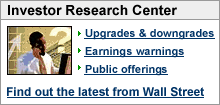Up month, up year?With just one session left in the month, those who follow the January Barometer are feeling pretty good right now.NEW YORK (CNNMoney.com) -- Investors, you'd better not send the market lower Wednesday, no matter what the Federal Reserve does or doesn't say at 2:15 p.m. ET. If the S&P 500 ends the month lower, there'll be hell to pay. Well, not quite, but according to the January Barometer, one of the more reliable market indicators around, "as January goes, so goes the year." And January is going well, despite a shaky start. According to the Stock Trader's Almanac, how the S&P 500 does in January tends to correlate with how the market does for the full year. Since 1950, the barometer has been right 91 percent of the time, according to the Almanac, or 75 percent of the time when you factor out years that ended essentially flat. As of Tuesday's close, the S&P 500 is up 0.7 percent in January of 2007. If it can hold those gains Wednesday, the last day of January, that could be a good sign, said Jeffrey Hirsch, editor of the Almanac. "If January 2007 ends slightly higher, that suggests that despite all the concerns that we may have politically, economically and in terms of interest rates, the stats are telling us the year looks positive," Hirsch said. But if it ends lower? Since 1950, every down January has led to a new or extended bear market, or a flat year. The Almanac's theory has been tested in a different form by Sam Stovall, Standard & Poor's chief investment strategist, who tracks what he calls the January Barometer Portfolio. According to his research, since 1970, a hypothetical portfolio of the 10 best-performing S&P industries in January has beaten the overall S&P 500 in the remaining 11 months of the year 75 percent of the time. January is particularly likely to influence the full year in a year like 2007, according to those who think the stock market follows the four-year cycle of the presidency. That's because 2007 is considered a "pre-election year." In such years, stocks have followed January's lead in 13 of the last 14 times. The lone recent exception was 2003, when stocks fell in January, bottomed out just ahead of the war in Iraq in March, and then bounced after uncertainty about the war was removed, rallying through year's end. Fear not hemlines Granted, quirky market indicators have to be taken with a grain of salt, as followers of the Super Bowl indicator and the hemline indicator can tell you. But the reasoning behind the January barometer is comparably sound: A positive January can give the market a built-in cushion for the rest of the year, if gains are big enough. Beyond that, events in January tend to influence how investors look at the rest of the year. Congress meets, and the President gives the State of the Union Address and provides the administration's agenda for the rest of the year. Additionally, investors tend to reshuffle their portfolios early in the year, putting money into play based on what they think will do well for the full year. Will this year be different? After all, the current bull market is getting old by historical standards - it turned four last October. And analysts say the fact that it hasn't seen a significant correction is a concern. Plus, you have an economy that's slowing, but perhaps not enough to suggest that the Federal Reserve will cut interest rates, as well as earnings that are slowing, which would contract P/E valuations. All of which could pressure stocks going forward. On the other hand, the Federal Reserve seems to be on its way to engineering a so-called "soft landing," inflation seems to be moderating and earnings growth, though slower, remains steady for the time being, said Ram Kolluri, chief investment strategist at GlobalValue Partners. All of which could support stocks, albeit modestly, through the rest of the year, regardless of how January ends. One other statistic on the side of the stock market: the aforementioned fact that 2007 is a "pre-election year." The S&P 500 hasn't ended a pre-election year lower since 1939, the start of World War II. |
|


